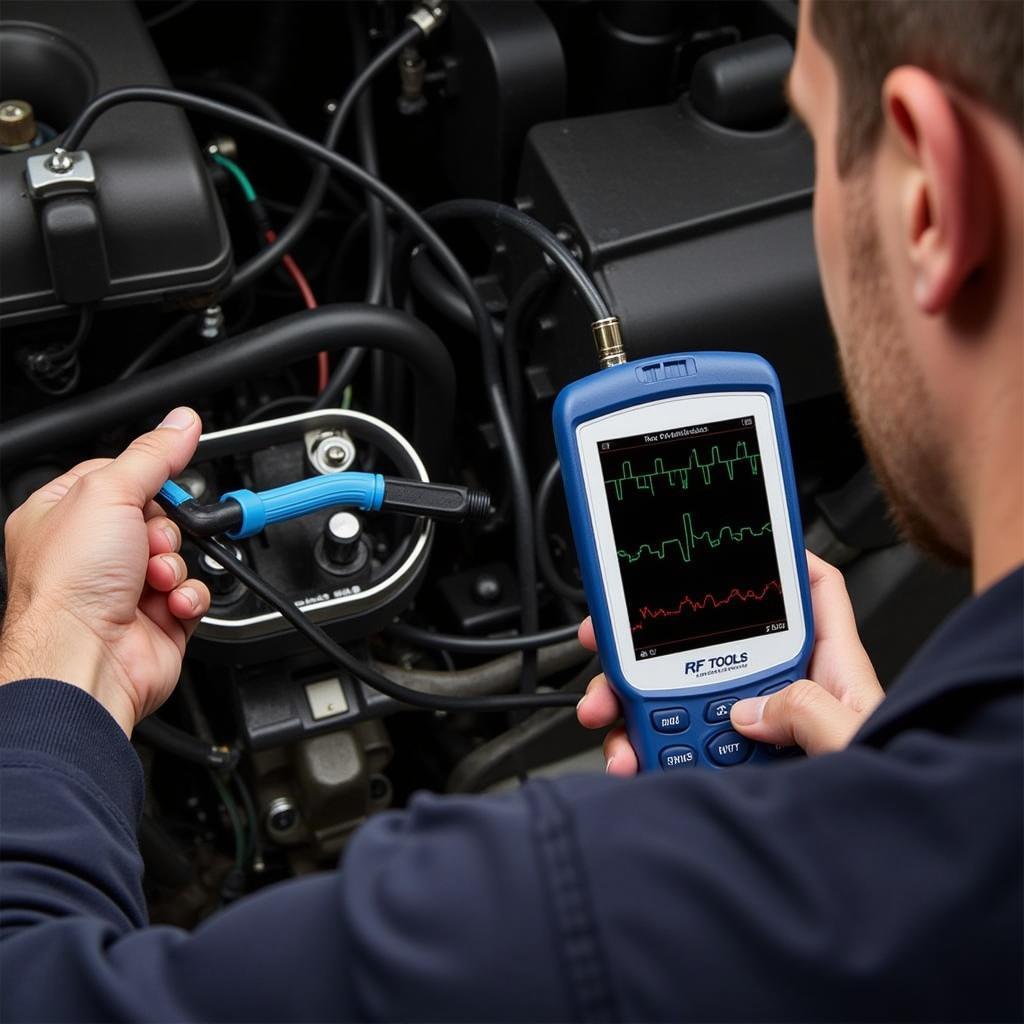Choosing the Best Scan Tool For Collision Repair is crucial for efficiently diagnosing and resolving post-accident vehicle issues. A reliable scan tool can save you time and money by pinpointing problems quickly, ensuring a proper repair and a safe return to the road. This guide will provide valuable insights into selecting and using the best scan tools for your collision repair needs.
After a collision, it’s essential to check for more than just visible damage. Modern vehicles are complex networks of electronic systems, and even a minor impact can disrupt these intricate connections. A sophisticated scan tool allows you to delve into these systems, identifying hidden issues that might otherwise go unnoticed. For example, a seemingly minor fender bender could affect the airbag system, and a specialized scan tool like a gm chevy air bag light scan tool can help diagnose such issues.
Understanding the Importance of Scan Tools in Collision Repair
Collision repair goes beyond fixing dents and scratches. It involves restoring the vehicle’s safety and performance to pre-accident condition. Scan tools play a critical role in achieving this by allowing technicians to:
- Diagnose fault codes related to airbag systems, ABS, and other safety features.
- Identify and address issues with the vehicle’s electronic control units (ECUs).
- Recalibrate advanced driver-assistance systems (ADAS) after repairs.
- Document pre and post-scan data for insurance claims and quality control.
A professional-grade scan tool is an investment that pays for itself through improved diagnostics, reduced repair time, and increased customer satisfaction.
 Technician Using Scan Tool for Collision Repair Diagnostics
Technician Using Scan Tool for Collision Repair Diagnostics
Key Features to Look for in a Collision Repair Scan Tool
Not all scan tools are created equal. When choosing a scan tool for collision repair, consider the following key features:
- Comprehensive System Coverage: The tool should be capable of diagnosing all major vehicle systems, including engine, transmission, ABS, airbags, and ADAS.
- Bi-directional Control: This feature enables technicians to activate various components, like actuators and solenoids, for testing purposes.
- Live Data Streaming: Real-time data monitoring helps pinpoint intermittent problems and verify repairs.
- Code Clearing Capabilities: After repairs, the tool should be able to clear fault codes and reset system parameters.
- User-Friendly Interface: A clear and intuitive interface simplifies the diagnostic process.
- Regular Updates: The automotive industry is constantly evolving, so the scan tool should offer regular software updates to maintain compatibility with newer vehicle models.
Remember, investing in a high-quality scan tool is an investment in your business’s future.
What are the different types of scan tools available for collision repair?
Different scan tools offer varying levels of functionality. Basic code readers can retrieve and clear generic fault codes. However, for comprehensive collision repair diagnostics, a professional-grade scan tool is necessary. These tools provide access to manufacturer-specific codes, bi-directional control, and advanced functionalities.
For example, if you specialize in BMW repairs, a bmw srs scan tool can be indispensable for diagnosing and resolving airbag system issues.
 Different Types of Automotive Scan Tools
Different Types of Automotive Scan Tools
How to Effectively Use a Scan Tool for Collision Repair
Using a scan tool effectively requires more than just plugging it in. Follow these steps for a thorough diagnostic process:
- Pre-Scan: Scan the vehicle before any repairs to identify pre-existing fault codes and establish a baseline.
- Diagnosis: After the collision, scan again to identify new fault codes related to the impact.
- Repair Verification: After completing repairs, perform another scan to confirm that all issues have been addressed and no new faults have been introduced.
- Documentation: Record all scan data throughout the repair process for insurance purposes and quality control.
“A pre-scan is essential,” says John Smith, Automotive Diagnostics Expert at Smith Automotive Solutions. “It not only helps identify pre-existing issues but also protects the repair shop from liability by documenting the vehicle’s condition before any work is performed.”
Advanced Applications of Scan Tools in Collision Repair
Beyond basic diagnostics, modern scan tools can perform advanced functions, such as:
- ADAS Calibration: Many newer vehicles are equipped with ADAS features like lane departure warning and adaptive cruise control. These systems often require recalibration after collision repair to ensure proper functionality.
- Programming and Coding: Some scan tools can program new modules and code replacement parts, eliminating the need for costly dealer visits.
- ECU Flashing: In some cases, the vehicle’s ECU may require a software update or reflash to address specific issues.
 ADAS Calibration Using Scan Tool
ADAS Calibration Using Scan Tool
A car code scanner srs can be particularly useful for diagnosing and resolving issues with supplemental restraint systems (SRS), commonly known as airbag systems.
Conclusion
Investing in the best scan tool for collision repair is a crucial step towards delivering high-quality repairs and ensuring customer satisfaction. By understanding the features, capabilities, and effective use of these tools, you can enhance your diagnostic process, save time and money, and ultimately provide a safer and more reliable repair service. Contact ScanToolUS at +1 (641) 206-8880 or visit our office at 1615 S Laramie Ave, Cicero, IL 60804, USA for further assistance with your scan tool needs.
FAQ
- What is the difference between a code reader and a scan tool? Code readers retrieve generic fault codes, while scan tools provide more in-depth diagnostics, including manufacturer-specific codes and bi-directional control.
- Why is a pre-scan important in collision repair? A pre-scan identifies pre-existing issues and establishes a baseline for comparison after the collision.
- Can a scan tool calibrate ADAS systems? Many professional-grade scan tools can perform ADAS calibration after collision repair.
- Do I need a different scan tool for different car makes? While some scan tools offer broad vehicle coverage, others specialize in specific makes or models.
- How often should I update my scan tool software? Regular software updates are essential to maintain compatibility with newer vehicles and access the latest features.
- What is bi-directional control, and why is it important? Bi-directional control allows technicians to activate components for testing purposes, aiding in accurate diagnosis.
- Where can I find reliable training on using automotive scan tools? Several online and in-person training courses are available to enhance your scan tool skills.


